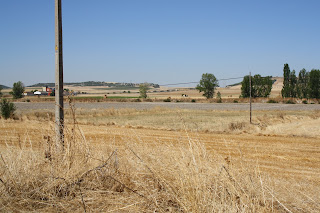Last week, I travelled from our green little corner of Galicia down to Madrid by car. My daughter had to take an exam in Madrid in preparation for college applications so I drove her down and we did some sightseeing at the same time. We had already made the same trip at the end of May and had been surprised by the endless fields of green wheat stretching away under the relentless blue skies after we had left the mountains and arrived at the "meseta". I remembered as a child flying from Santiago de Compostela to Madrid and looking down at brown fields, with little towns from which radiated long, straight roads. The green that surrounded us belied that memory.
This time, though, it was the last days of August. The wheat had been harvested and the fields were being turned over, leaving the rich, brown earth on view. The grasses covering small hills and the side of the roads were golden. The only green came from the occasional tree next to streams, some fields of sunflowers and the vineyards that surrounded Rueda, in the province of Valladolid. The sun was still strong in the almost white sky and you could feel its late-summer burn, though the breeze came fresh. Nearing Madrid and the foothills of the Guadarama gold still predominated through the scattered pines. There wasn't the sense of douceur the land holds in our northwest corner, where everything is green and the vastness of the woods hides the views. On the steppes of Castille everything was in plain view to the horizon, nothing was hidden.
History came to mind and I imagined Christian and Moorish armies battling on those fields, where the enemy would always be seen, no ambush possible. Earlier, even, the Romans, Greeks and Phoenicians confronting the primitive Celtic and Iberian tribes. Now we have cars, air conditioning, running water quickly brought up from underground and heating in winter. Thousands of years ago men decided to make their home on steppes that offered few streams, no shelter from the sun and little firewood to warm the cold nights; yet they set up their homes there, constantly battling their surroundings and sometimes their neighbors. Even only fifty years ago life was hard. Mechanization was not massively introduced until the economic boom of the 1960's. Until then farmers still used oxen and mules to work the fields as they had done for thousands of years.
Perhaps that is where the Spanish character was forged, on that inhospitable land open to sun, wind, and the fury of the elements. That land is the reason for Spanish self-reliance and stubborness.
This time, though, it was the last days of August. The wheat had been harvested and the fields were being turned over, leaving the rich, brown earth on view. The grasses covering small hills and the side of the roads were golden. The only green came from the occasional tree next to streams, some fields of sunflowers and the vineyards that surrounded Rueda, in the province of Valladolid. The sun was still strong in the almost white sky and you could feel its late-summer burn, though the breeze came fresh. Nearing Madrid and the foothills of the Guadarama gold still predominated through the scattered pines. There wasn't the sense of douceur the land holds in our northwest corner, where everything is green and the vastness of the woods hides the views. On the steppes of Castille everything was in plain view to the horizon, nothing was hidden.
History came to mind and I imagined Christian and Moorish armies battling on those fields, where the enemy would always be seen, no ambush possible. Earlier, even, the Romans, Greeks and Phoenicians confronting the primitive Celtic and Iberian tribes. Now we have cars, air conditioning, running water quickly brought up from underground and heating in winter. Thousands of years ago men decided to make their home on steppes that offered few streams, no shelter from the sun and little firewood to warm the cold nights; yet they set up their homes there, constantly battling their surroundings and sometimes their neighbors. Even only fifty years ago life was hard. Mechanization was not massively introduced until the economic boom of the 1960's. Until then farmers still used oxen and mules to work the fields as they had done for thousands of years.
Perhaps that is where the Spanish character was forged, on that inhospitable land open to sun, wind, and the fury of the elements. That land is the reason for Spanish self-reliance and stubborness.



Comments
Post a Comment